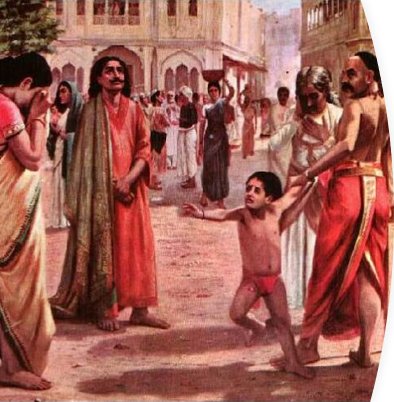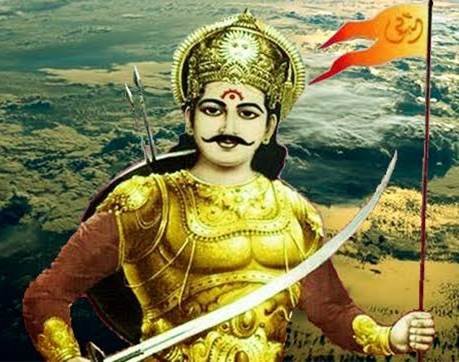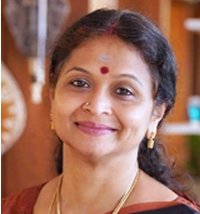
|
 |

|
 |
Unsung characters for adaptation in dance (Part 1)- Dr. Padmaja Sureshe-mail: padmajasuresh@hotmail.com June 11, 2025 Aesthetic experience says John Dewey in his Art as Experience, has been superimposed from systems of thought framed without direct reference to art. Rajashekhara in Kāvyamimāmsa, calls Sāhitya Vidya, Sarvapārṣada common to all Darshanas - hence we have drawn our aesthetic theory from concepts of Sānkhya, Nyāya-Mimāmsa, Vedānta, Tantra, Pratyabhij˝ya and all Bhakti schools. The Taittrīya Sootasamhita extolls the spiritual value of dance and music, both of which are performed incessantly by Śiva. Dance productions rely heavily on the poet, the scripts and the aesthetic value it holds. Choreography will depend on the artistic capabilities of imagination and skills to bring before the spectators, the popular legends and poems with added novelty or to bring to life a rarely exploited idea by inventing a production and discovering new possibilities of relish. The need to regulate Kama with Dharma and Mokśa sees the integration of beauty with goodness and truth all through our dance productions. Bhārat is indeed the home of storytelling. It was from here that the Persians learned the art, and passed it on to the Arab continent, Constantinople, Venice and so on. The book The Ocean of Story of Somadeva's Kathāsaritsāgara is a magnum opus, the earliest collection of stories extant in the world. Somadeva was a Kashmiri court poet of the 11 century. It contains 22, 000 slokas, nearly twice as long as the Iliad and Odyssey put together. We can find well-known tales from the epics, as well as Rig-Veda, the Vetālapancavimśati and also some original ones. Embedded or Nested Stories can be traced back to the Rāmāyaṇa, the Mahābhārata, Pa˝catantra, Jātakaṭṭhavaṇṇanā and the Kathāsaritsāgara. The authors of the Mahākāvya-s and Nātaka-s gave a portrait of the sublime hero, Dheerodātta or a Mahāpuruṣa. Rama of Valmīki was both Dharmātma and Gāndharve ca bhuvi Śreṣṭha, a master of music (Ayodhya Kānda). The origin of the Ādi Kavi marks a sheet-anchor of poetic theory being the embodiment of Rasa, as cited by Anandavardhana in his Dhvanyāloka. UNSUNG CHARACTERS Harishchandra Lord Rama's ancestor Harishchandra's commitment to Dharma at Ayodhya earned him a reputation far and wide. His unwavering dedication to truth crossed over personal gain and comfort. Sage Vishwamitra once approached Harishchandra to request a grand sacrifice. Harishchandra promised to fulfill the sage's request, no matter the consequences. He remained steadfast amidst-  Queen Taramati also called Shaivya, Harishchandra's devoted wife, played a significant role in this narrative. She stood by her husband with devotion and sacrifice. The climax of Harishchandra's trials came when he had to sell himself, his wife and son Rohitashwa into servitude. It so happens that Rohitashwa got bitten by a snake and he died. His mother took the body to the cremation ground and met her husband who was working there. Seeing his son's dead body, Harishchandra controlled himself and asked for tax to perform cremation. His wife had just her upper garment which she was about to offer, when all the gods appear. Even the Cāndala showed his real form as Yama and revived Rohitashwa. Harishchandra leaves an indelible mark on the virtues of truth. The 13th century Kannada masterpiece titled Harishchandra Caritra, written by Raghavanka of Hampi is a powerful kāvya, in the native ṣatpadi meter in Kannada and has been popularized by Gamaka, the art of singing classical literature in musical form as a moving lyric. Urmila In the Telugu land, are poems on Urmila Nidra and Lakshmana. After the trio's return from the forest, Rama regains the throne of Ayodhya while Lakshmana serves him in the court. Sita reminds Rama that Lakshmana should be advised to go to visit Urmila who has still been sleeping. Lakshmana goes to his wife's bedroom and gently wakes her up. Urmila does not recognize Lakshmana and questions him for intruding into her bed chamber. She warns him about the sin of coveting another man's wife. Who are you and why do you commit this sin? Lurking through narrow paths and lanes... If my father Janaka comes to know about this, he will punish and will not leave you. My husband will not let you escape with life. Lakshmana identifies himself to realize that he is none other than her husband. He in this poem, combs and braids Urmila's hair and she asks him about the events of past fourteen years. She wonders how Ravana could kidnap Sita when a courageous man like Lakshmana was around. Lakshmana tells Urmila about Sita's harsh words that forced him to leave her alone. The rest of the song details how affectionately they are in each other's arms.  Four out of the five ideal women are from Rāmāyana- Sita, Ahalya, Tara and Mandodari. Urmila should have been added perhaps. Haldhar Nag's anthology starts with a long poem "The Great Sati Urmila". It narrates Rāmāyana from Urmila's perspective. Highlighting her qualities the poet with references from regional Ramayana sings, unheralded unsung she is, In all seven books. For the poet in me, Sati she is, Even greater than Sita in purity. In Odisha, the Vilanka Rāmāyana is popular and was written by Sarala Das in 15th century. There are certain variations in these texts; for example, Kaikeyi had a vision that Ram would die if he ascended the throne and the only way to save him was banishment. Similarly, Urmila is acknowledged for her sacrifice, knowledge and purity. The only hint that the epic gives about Urmila is that she is the biological daughter of Janaka and is a learned woman. According to other sources, she was a great painter and extremely beautiful. Tulsidas has mentioned her as an epitome of beauty. According to a legend when Urmila came into Ayodhya, the first remark that Shanta (sister of lord Rama) made was about Urmila's beauty. While all had their husbands with them, she was the only one who did not have hers. Some versions mention that she did not step out of her room and that she slept for fourteen long years. Others say she didn't blink her eyes and was serving her mothers-in-law. She wasn't even permitted to grieve as per her husband's wish. We hear that she had two sons, Angad and Chandraketu - the Uttara Kānda mentions their kingdoms given by Rama. The famous Hindi poet, Maithili Sharan Gupta was so disappointed with Valmiki's treatment of Urmila, that he wrote his own epic by the name of Sāket, based it on Rāmāyana, whose heroine was not Sita, but Urmila! Rabindranath Tagore too is supposed to have lamented this treatment although Valmiki did mention that Urmila's sacrifice was unparalleled. Lord Rama's elder sister Shanta  The story of Lord Rama's elder sister Shanta is in the Valmiki's Bāla Kānda and Viṣnu Purāna. Shanta was the first child born to King Dasharata and Queen Kaushalya. Romapada, the king of Anga Desha, came to Ayodhya on a friendly visit and pleaded with Dasharata to give his daughter to him in adoption. Even though Shanta was his only daughter, Dasharata gave her away to his friend whose wife Varshini was Kaushalya's sister. Romapada became her foster-father. As time passed, Shanta was educated in the Vedas, arts and warfare. Rushyashringa had been instrumental in causing rain showers during famine in Anga Kingdom. King Romapada gave Shanta in marriage to him. Thus, the sage became the son-in-law of both Anga and Ayodhya. Putrakāmeṣṭi was performed by this sage with Shanta and Dasharata was blessed with four sons. Shanta is believed to have nursed King Dasharata on his deathbed. King Aja and Indumati's story (Cantos 6-8) Mahākavi Kalidasa's Raghuvamśam describes the dynasty of Emperor Raghu. The eighth chapter with 95 verses, has been translated here (with help from notes by Kishanrao Madhavarao Joglekar). Aja, Raghu's son, is celebrated for his love story with Indumati. Their union is depicted as divinely ordained, and Kalidasa excels in describing their romance. Raghu retires to be freed from worldly life. In due course, his soul is released and attains union with Supreme. The last rites are performed by the dutiful son. In course of time, Indumati, the queen gives birth to Dasharata. One day, while Aja and Indumati are amusing themselves in the palace garden, a garland of celestial flowers suddenly falls upon the wife from heaven which brings her life to an end. The picture of lamentation of Aja is highly pathetic. The body of the queen is consigned to the flames, and the bereaved husband later spends eight pensive years for the sake of his son, whereafter he leaves this mundane world. A few verses - Narada, the Minstrel Divine, was going along the path of the sun's course from the north to amuse with the music of his vina, Lord Shiva who was at Gokarna. Honeybees are swarming over that garland so far adorned on Narada's vina. The wind-god knocked off that garland, and the honeybees looked like the tears of Mahati, the vina of sage Narada. That heavenly garland far surpassed the seasonal splendor of earthly creepers with its nectar and fragrance. It fell on the surface of the full breasts of the king's beloved lady who became overpowered with agitation and closed her eyes in total darkness of eternal sleep, like the moon when the eclipsing planet Rāhu devours it. Aja held his queen whose condition was like that of a tuneless string instrument and placed her on his lap with which she was familiar. Even when delicate flowers can cut life short what else then, alas, cannot be the weapon of that butcher Destiny. Indumati's untimely death deeply affects Aja, illustrating the transient nature of life. 
It is said that the family priest Vashishta sent a message that once upon a time, Indra growing apprehensive of the rigorous penance practiced by Sage Trinabindu, sent the celestial damsel Harini to interrupt him. She was cursed, 'Be thou a mortal woman in the sub-lunary world.' 'I am entirely subject to the orders of another; please pardon my offensive conduct,' said the celestial damsel. The sage then ordained her to move about on this earth till she beheld celestial flowers. 'She became your queen Aja, and got the cessation of her curse as the garland fell on her. Enough is your brooding over her loss; birth entails death: this earth ought to be taken care of by you, since a king's regal bride is the earth. You cannot regain her even if you follow her in death; different are the paths of those that go to the other world, determined by their own actions here.' King Mandhata  King Mandhata was also a king of the Ikṣvāku dynasty. Mahābhārata says he was a son of the Sūryavanśa king Yuvanashva of Ayodhya who was childless. Once, he went on a hunting expedition and with thirst drank from a pot filled with water kept in a hermitage. Sage Bhrigu told him that the water was meant for his wives, so that they could give birth to many sons and now, Yuvanashva would give birth to a son who would emerge from his abdomen. The Devā-s led by Indra brought out the child and divine milk came out of Indra's fingers and nourished the baby. His prodigy was obvious and his growth was rapid, in knowledge of Veda-s and military sciences. Mandhata conquered Pātala and half of Svargaloka and became lord of the three worlds. He gave away colossal gold statues to the Brāhmana-s and cows as charity during the many Ashwamedha and Rājasūya Yag˝ß-s. Mandhata married the Chandravanśi princess Bindumati, the daughter of Shashabindu, King of the Yādava-s and their sons' stories are also related in the epic. Unsung characters for adaptation in dance (Part 2)
Unsung characters for adaptation in dance (Part 3)  An acclaimed dancer researcher and author, Dr. Padmaja Venkatesh Suresh is well-known for her immaculate insight into esoteric sciences, corelated with years of training and experience. Having toured extensively with her lectures, workshops and thematic performances, she leads Aatmalaya Academy, Bangalore, that propagates the cause of Sanatana Dharma and Vedic values through the arts. A PhD in dance and philosophy, she has several awards to her credit. Post your comments Pl provide your name and email id along with your comment. All appropriate comments posted with name & email id in the blog will also be featured in the site. |